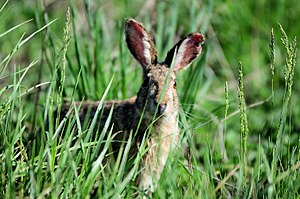Korean hare
| Korean hare | ||||||||||||
|---|---|---|---|---|---|---|---|---|---|---|---|---|

Korean hare ( Lepus coreanus ) |
||||||||||||
| Systematics | ||||||||||||
|
||||||||||||
| Scientific name | ||||||||||||
| Lepus coreanus | ||||||||||||
| Thomas , 1892 |
The Korean hare ( Lepus coreanus ) is a species of mammal belonging to the genus of the real hare within the hare-like species . Its distribution area is limited to the Korean Peninsula and the adjacent Chinese province of Jilin .
features
The Korean hare is a medium-sized type of hare with a body length of 42.5 to 49 centimeters and a weight of about 1700 grams. The tail length is 6 to 7.5 centimeters, the length of the ears 7.3 to 7.9 centimeters and the hind foot length 10.8 to 12.2 centimeters. It is slightly larger than the related Chinese hare ( Lepus sinensis ) and the fur is noticeably fuller than that of this species. The body color is spotty in various yellow and brown tones from light to red-brown with black interspersed, the underside is lighter. Compared to the Chinese hare, the proportion of black is higher. The tail is brown on top and white on the underside.
distribution
The distribution area of the Korean hare is limited to the Korean peninsula with the states of North Korea and South Korea and the extreme south of the Chinese province of Jilin , from which only one specimen has been scientifically known. It also occurs on the larger offshore islands.
Within the distribution area, it populates both the flatlands and mountainous regions, whereby it prefers especially shrubby areas.
Way of life
Very little information is available on the Korean hare's way of life. Like all hares, the species feeds primarily on grasses and herbs.
Systematics
The Korean hare is assigned to the real hare (genus Lepus ) as a species . The species status was partially canceled and the Korean hare was assigned to both the Chinese hare ( L. sinensis ) and the mountain hare ( L. timidus ).
The relationship has not been conclusively clarified, a closer relationship has been suggested with the Chinese hare ( L. sinensis ) as well as with the Japanese hare ( L. brachycera ) and the Manchurian hare ( L. mandshuricus ). Molecular biological studies confirmed the species status compared to the Chinese and Manchurian hare.
Hazard and protection
The species is rated by the International Union for Conservation of Nature and Natural Resources (IUCN) as "Least Concern" due to the size of the population and the relatively large distribution area. A decline in the population and a threat are not known.
It is also found in areas used for agriculture and forestry and can cause some damage, especially in plantations, through its feeding activity.
supporting documents
- ↑ a b c d e Korean Hare. In: Andrew T. Smith , Yan Xie: A Guide to the Mammals of China. Princeton University Press, 2008; P. 288. ISBN 978-0-691-09984-2 .
- ↑ a b c d Joseph A. Chapman, John EC Flux (Ed.): Rabbits, Hares and Pikas. Status Survey and Conservation Action Plan. (PDF; 11.3 MB) International Union for Conservation of Nature and Natural Resources (IUCN), Gland 1990, ISBN 2-8317-0019-1 .
- ↑ a b c d e Lepus coreanus in the endangered Red List species the IUCN 2011. Posted by: D. Murray, Andrew T. Smith , 2008. Accessed January 14, 2012 Design.
literature
- Joseph A. Chapman, John EC Flux (Eds.): Rabbits, Hares and Pikas. Status Survey and Conservation Action Plan. (PDF; 11.3 MB) International Union for Conservation of Nature and Natural Resources (IUCN), Gland 1990, ISBN 2-8317-0019-1 .
- Korean Hare. In: Andrew T. Smith , Yan Xie: A Guide to the Mammals of China. Princeton University Press, 2008; P. 288. ISBN 978-0-691-09984-2 .
Web links
- Lepus coreanus in the endangered Red List species the IUCN 2011. Posted by: D. Murray, Andrew T. Smith , 2008. Accessed January 14, 2012 Design.
